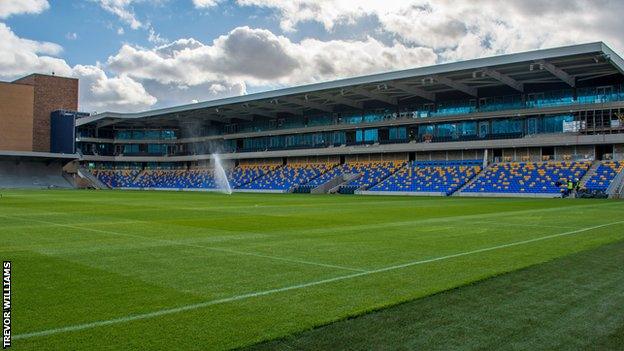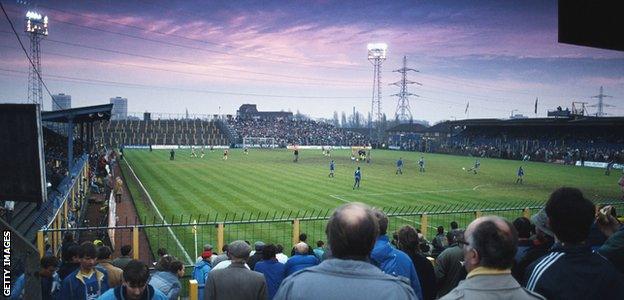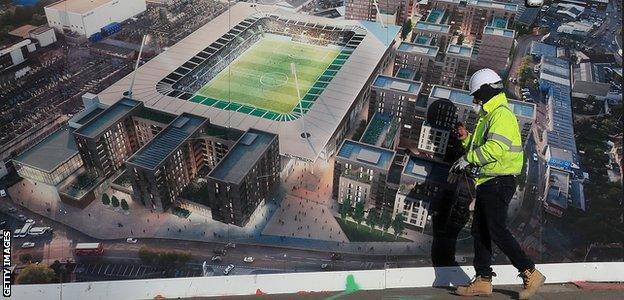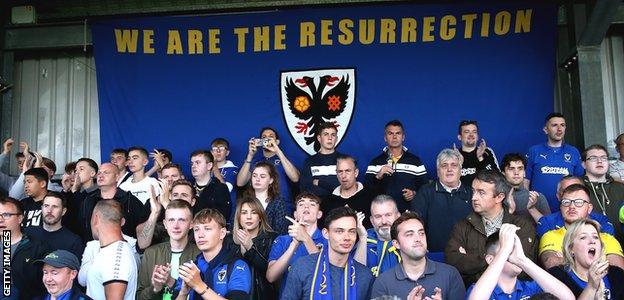AFC Wimbledon finish Plough Lane odyssey 18 years after formation
- Published

AFC Wimbledon's new ground at Plough Lane is a return to the club's spiritual home
On Tuesday evening, AFC Wimbledon will finally be home.
Eighteen years after starting life in the ninth tier, the Dons will move into their new stadium at Plough Lane as a League One club.
The road has been long and hard, and most supporters will tell you the wait for a ground to call their own stretches all the way back to 1991.
Even with the milestone achieved, fans will not be there to witness the first-ever game because of restrictions imposed during the coronavirus pandemic.
Yet a unique footballing odyssey will have a closing chapter.
The rebirth of a club
Formed in 2002, AFC Wimbledon had two founding aims; to return to the English Football League and return to playing in Merton, their spiritual home.
The phoenix entity was established by supporters of Wimbledon FC, external in response to the decision by an independent commission to allow the club to move to Milton Keynes.
The old Wimbledon relocated in September 2003 and were renamed MK Dons in 2004.
AFC Wimbledon made relatively light work of their first challenge, winning five promotions in the space of nine years to rise from the depths of the Combined Counties League and reach the EFL in 2011.
"We have been the underdogs all the way through and I have seen some amazing things," said Stuart Deacons of 9yrspodcast,, external a fan podcast about the Dons.
"We had to fight. Sometimes you have to pinch yourself and think 'did that really happen?'"
The on-pitch target realised, the second goal of a homecoming proved much harder to achieve.
Time in the wilderness

Plough Lane was home to Wimbledon FC from 1912 to 1991
When the original Wimbledon FC received permission to relocate to Buckinghamshire, the club had already been groundsharing for 11 years.
The Dons had moved out of Plough Lane in the summer of 1991 and become tenants at Selhurst Park.
The switch to Crystal Palace's home in Croydon came following the publication of the Taylor Report which, in the wake of the 1989 Hillsborough disaster, recommended that top-flight sides should play in all-seater stadiums.
"When we went to Selhurst Park we were told it would be temporary," said Graham Stacey, a board member of the Dons Trust, external - the democratic supporters' organisation which owns AFC Wimbledon.
"We could have reformed anywhere. But we have always represented Wimbledon, so playing there is everything."
AFC Wimbledon began their existence playing at Kingsmeadow, in Kingston upon Thames, the home of non-league Kingstonian.
The Dons bought the ground from the K's in 2003, but the wish to return to their own corner of south-west London remained.
"It is a long-held passion to get the club back to Merton," said Laurence Lowne, a fan since 1968 and now in his 60s.
"It was one of the desired aims of Wimbledon Independent Supporters' Association, which was formed in 1995.
"It has been one of the aims of the Dons Trust and has been part and parcel of the DNA of the club."
A home to call their own

AFC Wimbledon fans make a point that Plough Lane is their home during an FA Cup third-round tie against Liverpool in January 2015
The construction of a new stadium can be fraught with difficulties, especially in London, and even more so for a fan-owned club lacking funds.
The Dons launched their bid to return to Plough Lane in August 2012, but it was over two years before they could even submit a planning application.
With their old ground now turned into a housing estate, their intention was instead to redevelop Wimbledon Greyhound Stadium.
Permission to build was granted in December 2015, yet planning delays meant it was not until March 2018 that the site began to be cleared.
"The fact the land and the opportunity came up there, it was so poetic really," Stacey, 46, added.
"I'd have taken anywhere in Wimbledon, but to actually be back where it started, it couldn't have been written better."
Even then came a final financial hurdle in November last year, when the club announced it needed £11m by January to complete construction.
Wimbledon fans rallied once again, establishing the Plough Lane Bond which eventually raised over £5.4m and allowed the club to proceed.
"Wimbledon fans are an extraordinary bunch," said Charlie Talbot, who went to his first game in 1991 and is the co-creator of the Bond. "It was a phenomenal achievement.
"We are at our best when there is some slight air of crisis or calamity that needs to be averted."
The final construction contract was signed in May after investment from local businessman Nick Robertson, who became a new minority shareholder.
An odyssey at its end

A residential development, with about 600 new homes, is being built alongside AFC Wimbledon's new stadium
After beginning the 2020-21 campaign with a short-term groundshare with Queens Park Rangers, the Dons have finally realised their dream.
However, social distancing regulations mean no supporters will be in attendance for the landmark match against Doncaster Rovers.
Fans who have been fortunate enough to step inside the new stadium, which has an initial 9,300-capacity but has the potential to be expanded to 20,000, have been impressed.
"When you see plans for a ground, you can never quite grasp it until you see it," Deacons said.
"We have shared grounds like Selhurst, and we were at Kingsmeadow but we never really owned it.
"To now see a ground in blue and yellow colours and Dons on the seats is really, really exciting.
"It is a shame we have the stadium done and we can't get in there, but it just builds the appetite even more for when we can finally attend in numbers."
The club will display banners and flags from supporters in the stands, but Dons chief executive Joe Palmer has appealed to fans to refrain from gathering outside their new home., external
"It is not quite the way you want to open a stadium," Talbot, 40, added. "It is just an unfortunate manifestation, but we don't tend to do things the easy way at Wimbledon.
"It means that this feels more like a milestone than the big celebration. The journey isn't really complete until all the fans can be there and celebrate what we have all achieved."
'What we have done is correct'

AFC Wimbledon have won six promotions, including two via the play-offs, over the course of their 18-year history
Most AFC Wimbledon supporters still retain animosity towards fellow League One side MK Dons - a club which effectively came into existence by extinguishing the life of another.
The decision by the independent commission which sanctioned the relocation, external remains a controversial part of English football's history.
But that does not detract from AFC Wimbledon's own story, of fans rebuilding a club from nothing - beginning with open trials for players on Wimbledon Common.
"We will start the day at Plough Lane above that other club (MK Dons) in the table," Combyne said.
"It is really confirmation that what we have done is correct - and we went about it the correct way as well.
"Everyone has worked towards this. Every time we have had a big event, like the League Two play-off final at Wembley, you have seen supporters come out in their thousands.
"You saw the flags and people talking about excitement, and what was achieved every step of the way.
"It has been such a journey, and it is not going to be replicated ever."
So what next for AFC Wimbledon, the phoenix club who have finally achieved their dual aims?
"We have fulfilled the two parts of our re-founding ambition, so it is time to draw up some new plans," Talbot said.